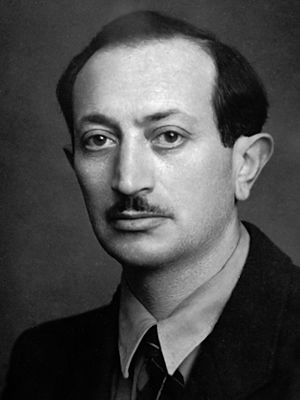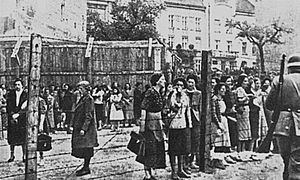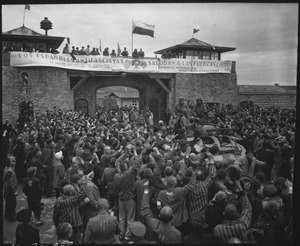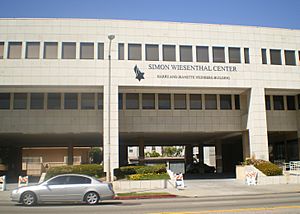Simon Wiesenthal facts for kids
Quick facts for kids
Simon Wiesenthal
|
|
|---|---|
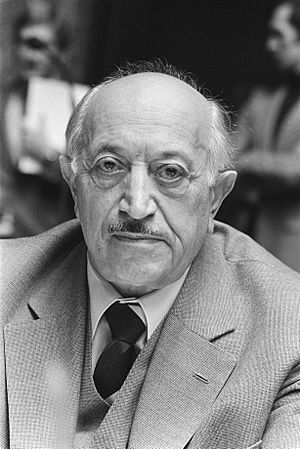
Wiesenthal in 1982
|
|
| Born | 31 December 1908 |
| Died | 20 September 2005 (aged 96) Vienna, Austria
|
| Resting place | Herzliya, Israel |
| Nationality | Austrian |
| Occupation | Nazi hunter, writer |
| Known for |
|
| Spouse(s) | Cyla Müller |
| Children | 1 |
Simon Wiesenthal (31 December 1908 – 20 September 2005) was a Jewish Austrian Holocaust survivor, a "Nazi hunter", and a writer. He studied architecture. When World War II began, he was living in Lwów. He survived several terrible places, including the Janowska concentration camp, Kraków-Płaszów concentration camp, Gross-Rosen concentration camp, and Mauthausen concentration camp.
After the war, Wiesenthal spent his life looking for Nazi war criminals. He wanted them to face justice for their terrible actions. In 1947, he helped start the Jewish Historical Documentation Centre in Linz, Austria. There, he and others collected information for future trials. They also helped refugees find their lost family members.
In 1961, he opened another office in Vienna. He continued to search for missing Nazi war criminals. He helped a little in finding Adolf Eichmann, who was caught in Argentina in 1960. Wiesenthal also worked with the Austrian government to gather information on Franz Stangl. Stangl was a camp commander who was later sent to prison for life.
In his later years, Wiesenthal was involved in some public events with Austrian politicians. He also wrote several books. He passed away in Vienna in 2005 at age 96. He was buried in Herzliya, Israel. The Simon Wiesenthal Center in Los Angeles is named after him. It continues his work of remembering the Holocaust and fighting against hatred.
Contents
Who was Simon Wiesenthal?
Simon Wiesenthal was born on 31 December 1908. His hometown was Buczacz, which was then part of Austria-Hungary. Today, it is in Ukraine. His father, Asher Wiesenthal, was a merchant. He had moved from Russia in 1905 to escape attacks on Jewish people.
Asher was a soldier and died in World War I in 1915. Simon, his younger brother Hillel, and their mother Rosa moved to Vienna. They returned to Buczacz in 1917. The area changed hands many times before the war ended in 1918.
Simon and Hillel went to high school in Buchach. Simon met his future wife, Cyla Müller, there. Hillel died in 1924 after an accident. Rosa remarried in 1926 and moved away. Simon stayed with the Müller family until he finished high school in 1928.
Simon loved art and drawing. He decided to study architecture. He wanted to go to Lwów Polytechnic but could not because of rules against Jewish students. Instead, he studied at the Czech Technical University in Prague from 1928 to 1932. He worked as a building engineer for a few years. He married Cyla in 1936.
There are different stories about what Simon did next. He wrote several books about his life. Some parts of his stories might have been changed to make them more dramatic. He said he opened an architecture office and later studied more in Lwów. Other records suggest he worked in factories until the Nazis invaded in 1941.
Surviving World War II
World War II started in September 1939 when Nazi Germany invaded Poland. Lwów, where Wiesenthal lived, was taken over by the Soviet Union. Wiesenthal's stepfather was arrested by the Soviets and died in prison. Wiesenthal's mother moved in with Simon and Cyla. Simon bribed an official to avoid being sent away from the city.
By July 1941, Wiesenthal and other Jewish people had to register for forced labor. In November 1941, the Nazis created the Lwów Ghetto. All Jewish people had to leave their homes and move into this crowded area. Thousands of Jewish people were murdered in Lwów in 1941. Wiesenthal said he was saved from execution by a former foreman who was now a Ukrainian police officer.
In late 1941, Wiesenthal and Cyla were sent to Janowska concentration camp. They were forced to work at a railway repair shop. Wiesenthal painted on train engines. Cyla polished metal. Wiesenthal got fake identity papers for Cyla from a Polish underground group. She went to Warsaw and survived the war working in factories. They were reunited in 1945. Their daughter, Paulinka, was born the next year.
The Nazis often rounded up people in the Lvov ghetto who could not work. Wiesenthal's mother and other elderly Jewish women were sent to Belzec extermination camp and murdered in August 1942. Around the same time, Cyla's mother was shot and killed. Between Simon and Cyla, 89 of their family members were murdered during the Holocaust.
Wiesenthal worked on architectural drawings for a senior inspector named Adolf Kohlrautz. Kohlrautz submitted the drawings under his own name. He shared some bribe money from construction companies with Wiesenthal. This allowed Wiesenthal to get information to the underground resistance. He even got weapons for them and for himself. He escaped in late 1943.
Wiesenthal said that on 20 April 1943, a Nazi officer decided to shoot 54 Jewish thinkers to celebrate Hitler's birthday. Wiesenthal was taken to the execution site. But he was called back. Kohlrautz had convinced his bosses that Wiesenthal was needed to paint a large poster for Hitler's birthday.
On 2 October 1943, Kohlrautz warned Wiesenthal that the camp would be destroyed. Kohlrautz gave Wiesenthal and another prisoner passes to go to town. They escaped from the back of a shop. Wiesenthal did not mention these events in his early statements after the war. Some historians question if these stories happened exactly as he told them.
After hiding for a few days, Wiesenthal went to a nearby village. He stayed there until the end of 1943. He later returned to Lvov and hid in an apartment. He was arrested again on 13 June 1944. He was taken back to the Janowska camp. Soviet forces were getting closer. The remaining prisoners were moved to Przemyśl to build defenses.
By September, Wiesenthal and other survivors were sent to the Kraków-Płaszów concentration camp. In October, they were moved to Gross-Rosen concentration camp. Conditions were very bad there. Wiesenthal's toe was injured while working in a quarry. In January, the Soviets advanced again. The prisoners were forced to march to Chemnitz. Wiesenthal was one of the few who survived this march.
From Chemnitz, prisoners were taken in open freight cars to Buchenwald. A few days later, they went by truck to Mauthausen concentration camp. They arrived in mid-February 1945. More than half the prisoners died during the journey. Wiesenthal was put in a section for the very sick. He survived on very little food until the camp was freed by American soldiers on 5 May 1945. He weighed only 41 kg (about 90 pounds) when he was freed.
Becoming a Nazi Hunter
Within three weeks of being freed, Wiesenthal made a list of about 100 suspected Nazi war criminals. These were mostly guards and camp commanders. He gave the list to American investigators. He worked as an interpreter, helping officers arrest people. He was still very weak.
When Austria was divided by the Allies in 1945, Wiesenthal moved to Linz. He lived in a camp for displaced people. He helped Jewish refugees and tried to find missing family members. He also helped an underground group that smuggled Jewish survivors into Palestine.
In February 1947, Wiesenthal and 30 volunteers started the Jewish Documentation Center in Linz. They collected information from concentration camp survivors. They gathered over 3,000 statements. However, as the US and Soviet Union became less interested in trials, Wiesenthal's office closed in 1954. Most of the documents were sent to the Yad Vashem archives in Israel. Wiesenthal continued to work with refugees. He believed survivors had a duty to seek justice. His work became a way to remember those who were lost.
Finding Adolf Eichmann
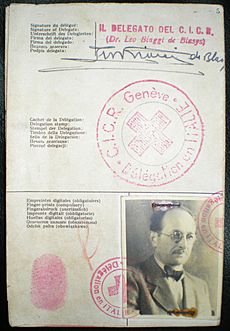
Simon Wiesenthal stayed in Linz partly because the family of Adolf Eichmann lived nearby. Eichmann was a high-ranking Nazi. He was in charge of sending Jewish people to their deaths. After the war, Eichmann hid in Austria using fake papers. In 1950, he moved to Argentina under a false name.
Wiesenthal kept an eye on Eichmann's family in Linz. He hoped to find out where Eichmann was. In 1953, he learned that Eichmann had been seen in Buenos Aires. He shared this information with the Israeli consulate in Vienna in 1954.
In 1960, when Eichmann's father died, Wiesenthal arranged for private detectives to photograph family members. Eichmann's brother looked a lot like him. Wiesenthal gave these photos to Mossad agents on 18 February. Mossad is Israel's national intelligence agency. One of the agents, Zvi Aharoni, said the photos helped confirm Eichmann's identity.
Eichmann was captured in Buenos Aires on 11 May 1960. On 23 May, Israeli Prime Minister David Ben-Gurion announced Eichmann's arrest. Wiesenthal became well-known. He wrote a book called Ich jagte Eichmann (I chased Eichmann). It was published before Eichmann's trial began in 1961. Wiesenthal helped the prosecution and attended part of the trial. Eichmann was sentenced to death and hanged on 1 June 1962.
In 1960, Wiesenthal's employers let him go because there were fewer refugees. So, in 1961, he opened a new documentation center in Vienna. He also worked for the Mossad, getting paid to find Nazi war criminals. He kept files on hundreds of suspects. He helped locate several, leading to their arrests.
One success was finding Erich Rajakowitsch, who was responsible for sending Jews from the Netherlands to camps. Another was Franz Murer, the commander of the Vilna Ghetto. In 1963, Wiesenthal learned that Karl Silberbauer, the man who arrested Anne Frank, was working as a police officer in Vienna. Wiesenthal's efforts led to Silberbauer being suspended, but he was never charged for arresting the Frank family.
Wiesenthal's center in Vienna was taken over by a local group in 1963. He then started a new, independent office. It was funded by donations and his Mossad pay. He pushed for the time limit on German war crimes to be extended. This helped ensure that more criminals could still be brought to justice. However, as time passed, it became harder to get convictions. Witnesses were older, and governments were less interested in pursuing old cases.
Finding Hermine Braunsteiner
Hermine Braunsteiner was a guard known as "the Mare of Majdanek." She worked at Majdanek and Ravensbrück concentration camps. She had served a three-year sentence in Austria for her actions at Ravensbrück. But she had not been charged for her crimes at Majdanek. She moved to the United States in 1959 and became an American citizen in 1963.
Wiesenthal first heard about Braunsteiner in 1964. Someone he met in Tel Aviv had seen her choosing who would be sent to slave labor and who would be murdered in the gas chambers at Majdanek. Wiesenthal found out she was living in Queens, New York. He told the Israeli police and the New York Times.
It took a long time, but Braunsteiner was finally sent to Germany in 1973. Her trial included nine other people accused of killing 250,000 people at Majdanek. She was sentenced to life in prison in 1981. She was released in 1996 due to health issues and died in 1999.
Searching for Josef Mengele
Josef Mengele was a doctor at Auschwitz concentration camp from 1943 until the end of the war. He chose who would live or die when prisoners arrived. He also performed cruel and deadly experiments on inmates. He left the camp in January 1945 as the Soviet army approached. He was briefly held by Americans but was released. He worked on a farm in Germany until 1949.
Mengele then used a Red Cross passport to escape to Argentina. He started a business in Buenos Aires in 1951. West German authorities tried to get Mengele sent back in 1960, based on information from Wiesenthal. But Mengele could not be found. He had moved to Paraguay in 1958 and then to Brazil in 1961. He drowned while swimming in 1979.
Wiesenthal claimed to have information that Mengele was in different places over the years. He said Mengele was in Greece in 1960, Cairo in 1961, Spain in 1971, and Paraguay in 1978. In 1982, Wiesenthal offered a reward of $100,000 for Mengele's capture. He insisted Mengele was still alive as late as 1985, even though Mengele had died six years earlier. Mengele's family admitted in 1985 that he had died in 1979. His body was dug up and identified.
Simon Wiesenthal Centre
The Simon Wiesenthal Centre in Los Angeles was started in 1977 by Rabbi Marvin Hier. He paid Wiesenthal for the right to use his name. The center helped remove the time limit on Nazi crimes. It continues to search for suspected Nazi war criminals. Today, its main work is remembering the Holocaust, educating people, and fighting against antisemitism (hatred of Jewish people).
Wiesenthal was not always happy with how the center was run. He felt its Holocaust museum was not serious enough. He also thought he should have more say in how things were done. He even asked for Rabbi Hier to be removed. In the end, he remained a public figure for the center.
Later Life and Legacy
Austrian Politics and Public Life
Bruno Kreisky and the Nazi Party
When Bruno Kreisky became the leader of Austria in April 1970, Wiesenthal told the press that four of his new government members had been part of the Nazi Party. Kreisky became angry. He called Wiesenthal a "Jewish fascist" and compared his organization to the Mafia. He also accused Wiesenthal of working with the Nazis.
Wiesenthal sued Kreisky for making false statements. The lawsuit ended in 1989, with the court ruling in Wiesenthal's favor. After Kreisky died, his family refused to pay. Later, when old records were opened, no proof was found that Wiesenthal had worked with the Nazis.
Kurt Waldheim's Past
When Kurt Waldheim became the head of the United Nations in 1971, Wiesenthal said there was no evidence he had a Nazi past. This was based on earlier checks by American investigators. However, Waldheim's 1985 autobiography did not mention his war service after 1941. When he returned to duty in 1942, he was in Yugoslavia and Greece. He knew about murders of civilians there.
In 1986, during his campaign to become Austria's president, a magazine reported that Waldheim had been a member of a Nazi group. The New York Times also reported that Waldheim had not told the full truth about his war service. Wiesenthal was embarrassed. He tried to help Waldheim defend himself. The World Jewish Congress investigated, but there was not enough evidence for a conviction. Waldheim was elected president in July 1986.
A group of historians later found that Waldheim did not commit atrocities himself. But he must have known they were happening and did nothing. Wiesenthal asked Waldheim to resign, but he did not. The World Jewish Congress successfully pushed for Waldheim to be banned from entering the United States.
Sails of Hope
In 1968, Wiesenthal published a book called Sails of Hope: The Secret Mission of Christopher Columbus. This was his first non-fiction book not about the Holocaust. In it, Wiesenthal suggested that Christopher Columbus was a Sephardi Jew from Spain. He believed Columbus secretly practiced his religion to avoid being persecuted.
Most historians believe Columbus was from Italy. But Wiesenthal argued that Columbus's journey to the New World was not just for money or fame. He thought Columbus wanted to find a safe place for Jewish people. At that time, Jewish people in Spain faced terrible persecution. Wiesenthal also believed Columbus's idea of "sailing west" came from old Bible prophecies.
Awards and Retirement
Wiesenthal was nominated for the Nobel Peace Prize in 1985. Another Holocaust survivor, Elie Wiesel, also nominated, campaigned hard for the prize. Wiesenthal did not do much to promote himself. When Wiesel won the prize in 1986, Wiesenthal claimed a Jewish organization had influenced the decision. Some people think Wiesenthal lost because of the negative news about the Waldheim case.
In 1992, Wiesenthal received the Erasmus Prize. In 2004, the British Government gave him an honorary KBE.
Wiesenthal received many threats over the years. In 1982, a bomb placed by neo-Nazis exploded outside his house in Vienna. After that, police guarded his home 24 hours a day. His wife, Cyla, found the stress of his work very difficult.
Wiesenthal continued to work at his office even as he got older. He finally retired in October 2001, when he was 92. The last Nazi he helped bring to trial was Julius Viel, who was found guilty in 2001. Wiesenthal said, "My work is done." Cyla died in 2003, and Wiesenthal died in 2005. He was buried in Herzliya, Israel.
After Wiesenthal's death, many leaders praised him. Terry Davis, chairman of the Council of Europe, said Wiesenthal's efforts were key to Europe healing its wounds. He called Wiesenthal "a soldier of justice." In 2010, Austria and Israel issued a special stamp honoring Wiesenthal. He had become a stamp collector after the war to help him relax.
Dramatic Stories and Films
Simon Wiesenthal has been shown in movies and TV shows.
- In the 1974 film The Odessa File, he was played by Israeli actor Shmuel Rodensky. After this movie, people reported seeing a Nazi criminal named Eduard Roschmann. These reports helped lead to Roschmann being found, though he died soon after.
- In the novel The Boys from Brazil, the character Yakov Liebermann is based on Wiesenthal. Laurence Olivier played him in the 1978 film. Olivier visited Wiesenthal for advice on the role.
- Ben Kingsley played Wiesenthal in the 1989 HBO film Murderers Among Us: The Simon Wiesenthal Story.
- Judd Hirsch played him in the 2020 Amazon Prime Video series Hunters.
Wiesenthal has also been the subject of several documentaries:
- The Art of Remembrance: Simon Wiesenthal (1994)
- I Have Never Forgotten You: The Life and Legacy of Simon Wiesenthal (2007), narrated by Nicole Kidman.
- Wiesenthal is a play written and performed by Tom Dugan that started in 2014.
Images for kids
 In Spanish: Simon Wiesenthal para niños
In Spanish: Simon Wiesenthal para niños
- Vienna Wiesenthal Institute for Holocaust Studies
- List of awards received by Simon Wiesenthal
- Beate Klarsfeld
- Serge Klarsfeld
- Yaron Svoray
- Efraim Zuroff


